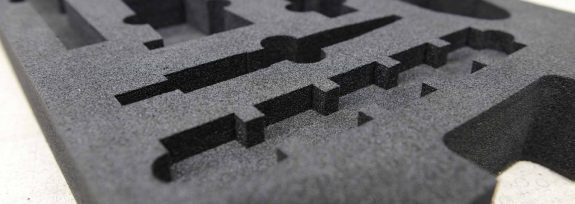How to cut foam?
PRP has a very specialized capability in the cutting and fabrication of foam due to our wide range of different machinery

Foam cutting is actually a bit of a complex process! While it can appear quite soft and ‘easy’, material properties can lead to many difficulties that lead to a messy, rough and inaccurate cut. Our knife cutting machinery, laser cutting machinery, routers and die cutters all feature slightly different cutting operations, and therefore can cater to a range of complexities and constraints, such as foam thicknesses, foam density, cutting custom profiles, intricacies and tolerances.
Below are several factors which can sometimes make intricate foam cutting more complicated than that of steel or other metals on comparable machinery.
- Thickness
- Generally the thicker the material, the more difficult it can be for a CNC machine to cut. This is primarily due to the distance (height) that the cutting technology has to penetrate through, whether by single of multiple passes. Single pass thick materials (50mm+) can exhibit large variations in tolerances, edge finish and distortion if not properly controlled during the cutting process.
- When cutting steel on flatbed machinery, the thickness is very much proportional to the speed and quality of the cut. The thicker the steel, generally the much slower the cutting speed, and especially so if desiring a high quality even cutting edge. Thick steel (50mm+) is best cut on waterjet machines or very high-powered laser machines, with the tradeoff’s in speed and power generally resulting in much higher costs to cut.
- With foam on the other hand, our knife cutting machinery can cut over 100mm thick with higher cutting speeds all while maintaining excellent edge quality. Our knife technology does not suffer from edge distortion, nor quality from top to bottom, meaning consistent edge thickness when measuring from the top of the product or bottom. More so, as foams are much softer than metals, our cutting speeds can be up to 20x faster, resulting in reduced cutting cost per similar volume or profile.
- Density
- Along with thickness, density can also impact speed when cutting foam. Density is measured in kg/m^3, and is effectively the weight of a product per unit of volume. Typical common foams are around 30 kg/m3, but can span anywhere from 10 kg/m3 up to 400 kg/m3. Steel on the other hand can have densities up around 7800 kg/m3, therefore making them incredibly more difficult to handle, maneuver, cut, and fabricate!
- Each of our CNC cutting machines can handle densities in slightly different ways. Our flatbed knife machinery can cut all foam in any density, but can be finetuned depending on the density itself, the intricacy of profile, and whether there is any other medium involved (such as an adhesive). Our die cutting machinery can cut denser materials in thinner profiles, or with the use of high knife rules, can cut thicker foams with softer densities. This technology is particular useful for higher volume low-cost packaging. Routing technology can be fantastic for very high dense foams as the high rotational speed and specialized cutters can create very intricate profiles to high precision. Lastly our laser cutting technology can cut high density foams in thinner profiles but to very high precision and tight intricacies.
- Intricacies, profiles and tolerances
-
- The intricacy of the profile and potential tolerances fundamentally drives how our team engineers and programs the CNC cutting machinery. Highly intricate profiles (such as those with very small radius or very close cut lines) can be incredibly difficult to cut for very soft and/or thick material as the chances for movement or variation is much higher. This also creates problems with tolerancing, as softer materials can become difficult to measure accurately. As the material gets thinner, or composition becomes more favorable, the ability to increase precision of reduce tolerances errors become much easier to manage. That said, tolerances for foam can still be incredibly tight. Our knife cutting machinery has shown achievable tolerances down to +/- 0.05mm, while our laser technology has seen tolerances down to +/- 0.03mm for very thin rigid substrate. These tolerances are superior, or just as effective, to many cutting technologies cutting much stronger and rigid materials.
What foam can we cut?
Our CNC foam cutting technology can cut a wide range of different foams, such as PE, EVA, Polyurethanes, Polyesters and specialty formulations. Our material scope also extends beyond foam into sponges, such as EPDM, neoprene, nitrile and silicone and much much more.
Conclusion
PRP has a very extensive foam cutting service that caters to a wide variety of custom foam cutting projects. We also stock a very large range of different foams, including those with unique properties such as fire-retardant anti-static (FRAS), foams with very low thermal conductivity, high-temperature resistance, and those addressing sound attenuation applications.
Please feel free to contact us and one of our friendly staff will be more than happy to discuss any projects or requirements.
